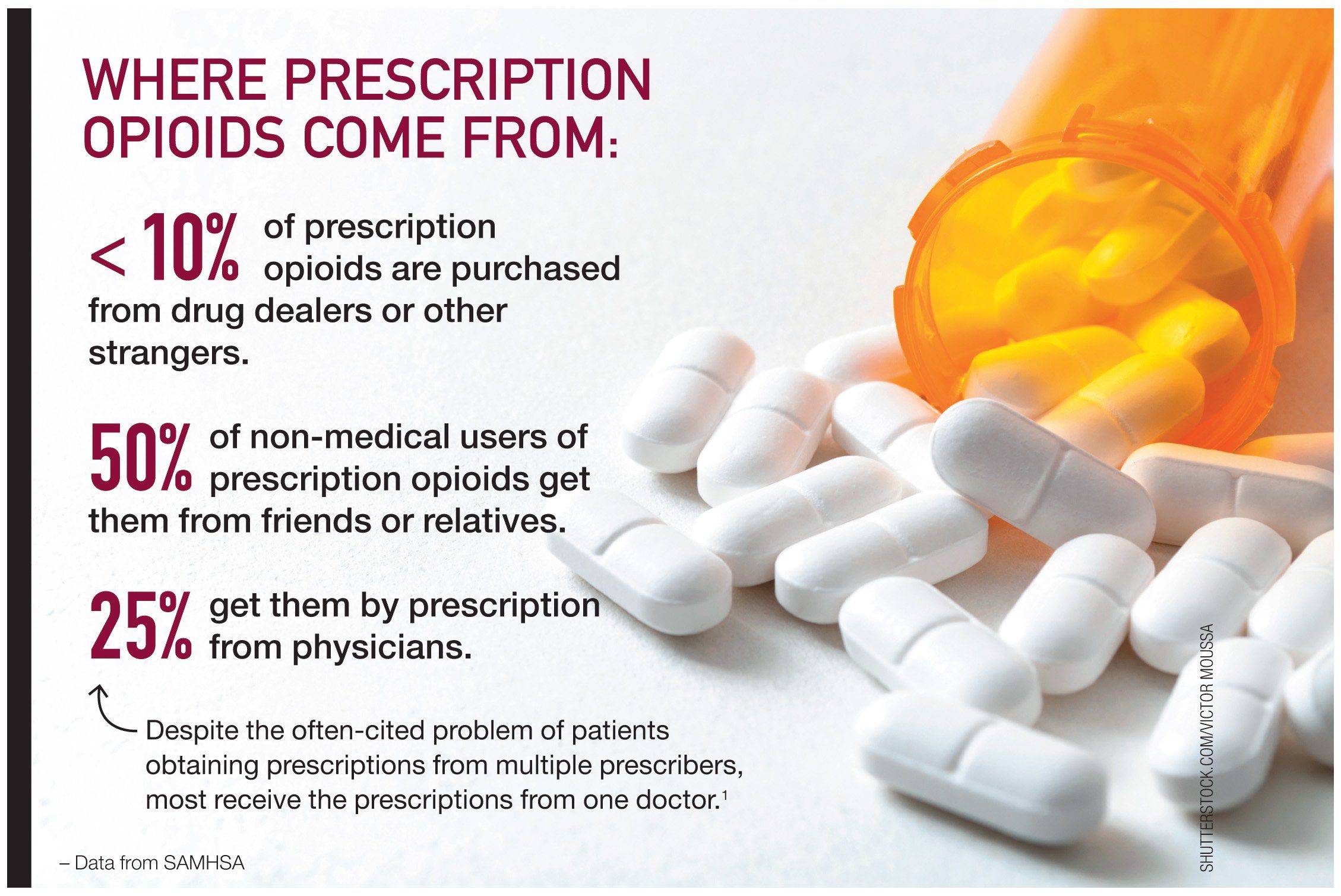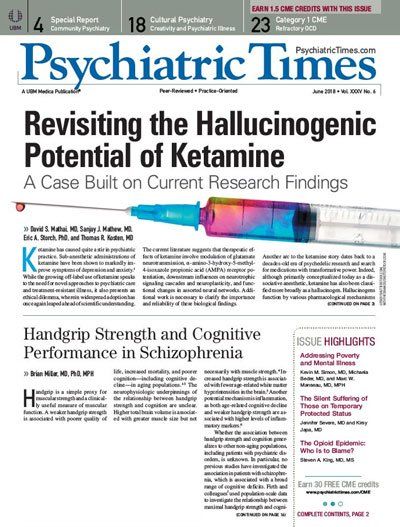Publication
Article
Psychiatric Times
The Opioid Epidemic: Who Is to Blame?
Author(s):
Research published more than 25 years ago was already reporting problems with opioid analgesics.

PAIN MANAGEMENT
Editor's note: To read The Opioid Epidemic: Who Is to Blame? - A Reader Responds, click here.
If there is one thing in the US upon which there is virtually universal agreement, it is that we are in the midst of an opioid epidemic. However, whom or what is to blame for this is not as clear and should be the subject of greater discussion. So far, most of the blame has been placed at the doorstep of illicit drug dealers and the pharmaceutical companies that manufacturer opioids. There is no doubt that both have contributed to it, but their share of the responsibility for the epidemic is overstated.
Drug dealers are obviously the source of illegal drugs such as heroin and various forms of fentanyl not available by prescription in the US. However, data from SAMHSA indicate that when it comes to prescription opioids, drug dealers play a limited role in the supply chain. Fewer than 10% are purchased from drug dealers or other strangers. Approximately 50% of non-medical users of prescription opioids get them from friends or relatives; 25% get them by prescription from physicians. Despite the often-cited problem of patients obtaining prescriptions from multiple prescribers, most receive the prescriptions from one doctor.1
Several state and local governments have instituted lawsuits against some of the pharmaceutical companies. The lawsuits claim that the companies purposely misled physicians about the addiction potential of their products; the Federal government is currently deciding whether to join these suits. The main target of these suits is Purdue Pharma, the manufacturer of the now infamous OxyContin, although other companies have also been included.
There is no doubt drug companies have aggressively marketed products that contributed to the epidemic. Although the tobacco companies’ accepting the responsibility for the health consequences of their products and the consequent settlements have been cited as a model for what should be required of opioid manufacturers, there is a marked difference between the two. Tobacco companies sold their products directly to consumers whereas patients legally obtain opioids from physicians and dentists who write the prescriptions.
Over the course of my career, I have dealt with many representatives of pharmaceutical companies. The majority are ethical, and a number have asked for my input on the positive and negative aspects of their products based on my experience in pain management. There have also been representatives who were willing to make what at best might be described as misleading statements. Some may have done so out of ignorance, but others knew what they were saying wasn’t true.
Whether good or bad, pharmaceutical company representatives are sales people trying to get physicians to prescribe their products. I believe that any medical professional who claims that whatever errors he or she made was because of what these representatives told them probably shouldn’t be practicing medicine and certainly not prescribing medications. If we accept the argument that these doctors were misled, then it must be asked how someone who spent 4 years in medical school and at least an additional 3 years in postgraduate training could be so ignorant about opioids.
Another cited culprit for over- prescription of opioids is the recommendation of several professional organizations to make pain “the fifth vital sign” with physicians simply being innocent contributors to the epidemic. This suggests a widespread belief among physicians that opioids are either the only or the most effective analgesics; thus, if a patient is in pain, there is no alternative to opioids.
What is overlooked is that at the same time the number of opioids being prescribed in this country was increasing, there was never a corresponding decrease in how many people were suffering pain. Furthermore, when doctors say no one could have foreseen that patients prescribed opioids for legitimate pain complaints might end up abusing them, they fail to note that research published more than 25 years ago was already reporting problems with opioid analgesics.2
What is the source of all this ignorance? The answer is easy. If a child went to school yet was unable to read or perform basic math, we’d blame it on the inadequacy of the education he received. Similarly, if doctors finish medical school and postgraduate programs without adequate knowledge about opiods, it’s the fault of those who taught them.
I completed my fellowship in pain management 30 years ago. The one consistent thing since that time has been that every report and study, of which there have been many, has cited the inadequate education most US physicians receive about pain management.3,4 Yet, I have not seen any blame for the opioid epidemic being attributed to lack of education-and this is where the largest share of blame lies. Considering the many major advances in medicine in the past few decades, one would think that someone might have figured out by now how to educate physicians about pain management.
So why, so long after the problem was recognized, does it continue to exist? I believe there are several reasons, none of which have to do with science but rather with academic politics and money.
Because doctors in all specialties are likely to encounter patients with pain, pain management becomes the rare medical problem that doesn’t fall neatly under the purview of any single specialty. This has resulted in teaching on the subject to fall into the cracks between where each specialty begins and ends.
In most academic medical centers, pain management is under the purview of anesthesiology departments. The problem is that any way one looks at this, it doesn’t make much sense. I have a great deal of respect for anesthesiologists and the important services they provide. However, even most of those who perform pain fellowships have little training in managing chronic pain and have little interest in managing acute pain with the exception of perioperative pain or that related to traumatic injury. What anesthesiologists who specialize in pain management mostly provide are various procedures, most of which-such as epidural steroid injections for low back pain-have little research to support their use. Moreover, many anesthesiologists who practice pain management have little interest in medication management and limited training in the use of oral analgesics-and most probably receive less education on substance abuse and addiction than physicians in other specialties.
Anesthesiology’s claim to primacy on the management of chronic pain appears to have stemmed from economic reasons. The “RAPs” (radiology, anesthesiology, pathology) proposal introduced several years ago was for practitioners of these specialties to become hospital employees which, in many cases, would have resulted in a reduction in their income. As a result, anesthesiologists began to look for services they could provide outside of the operating room.
So, if not anesthesiology, which medical specialty should be taking the lead in educating physicians about pain? It seems to me that it makes most sense for psychiatry to take on the role of teaching pain management. For years, the major international organization for pain management specialists, the International Association for the Study of Pain, has defined pain “as always being a psychological state.”5,6 Moreover, every guideline on the management of chronic pain, that I know of, has highlighted that in most cases there is a major psychological component to pain and that psychologically based treatments are among the most effective.7,8
It is also easy to make the case for psychiatry to be responsible for the medication management of pain. Two of the most important classes of analgesics for chronic pain are the SNRIs and the anti-epileptics. Although most psychiatrists don’t receive much training in the use of opioids as analgesics, they do receive education in opioid use disorder and its treatment. It appears that more and more psychiatrists see their role in pain management as being limited to treating patients who become addicted to opioids. However, psychiatrists could play a vital role in not only preventing opioid addiction but also providing pain management.
I realize that psychiatry departments would have a hard time wresting away pain management from anesthesiology. Procedures bring in a great deal of money and anyone in academic medicine is aware that the hierarchy of departments is largely based on revenue so psychiatry will always be near the bottom. There is also the fear that if pain management was included under psychiatry, patients with pain might fear they are being viewed as being “crazy” and their pain not taken seriously. An additional problem is that there are only a small number of psychiatrists with training and experience in pain management, but I believe there is a sufficient number to make a start.9
In Shakespeare’s Julius Caesar, Cassius says to Brutus, “The fault, dear Brutus, is not in our stars but in ourselves.” When it comes to the opioid epidemic, the fault is not primarily in pharmaceutical companies, unethical physicians, or pain being the fifth vital sign, as many would have us believe. Rather the fault lies primarily in the medical education system that has chosen to place money over science in deciding how and by whom pain management should be taught.
We can’t do much about unethical physicians or pharmaceutical companies, but we should be able to have a significant impact upon how future generations of physicians are educated. If we continue to allow them to be poorly educated about pain management and opioids, we cannot expect things to change for the better. A reduction in the number of opioids prescribed is a laudable goal because it is clear that too many are currently prescribed. But unless we change the education system, there is no guarantee that those reductions will have an impact on the opioid crisis or that patients will have their pain properly managed.
From our partner publication
Neurology Times is monitored and developed by the editors of Psychiatric Times. The mission of NT is to provide quick reference and clinical guidance for neurologists and other clinicians caring for patients with neurological disorders. It is a natural fit for our journal, as psychiatry and neuroscience often intermingle.
Cognitive Impairment: Men Vs Women
A new study finds that cognitive impairment progresses faster in men than in women.
The Neglected Diagnosis: Mood Disorders in Patients With Epilepsy
Which came first? Epilepsy or depression? The author sheds light on a complex relationship.
The Neuroscience of Social Embarrassment
Watching events unfold when humans are subject to public embarrassment can lead to vicarious feelings-and change activity in the brain.
LETTER TO THE EDITOR
The Opioid Epidemic: Who Is to Blame? - A Reader Responds
Reese Tyrell (pseudonym)
I am writing in response to Dr. Steven A. King’s article “The Opioid Epidemic: Who Is to Blame?” from Vol. 35, issue 6 (June 14, 2018). I have never been Dr. King’s patient, but I’m reaching out to doctors writing in this area who may not have ever seen a patient like me. I object to the statement that pain is always a “psychological state,” and that “in most cases there is a major psychological component to pain.”
Some diseases, often genetic, cause constant tissue damage. One example would be IC/BPS [interstitial cystitis/bladder pain syndrome], which I have had my entire adult life. The inside of my bladder is lined with cuts that don’t heal. The pain I experience is not caused by nervous system malfunction, but by salty liquid dripping and pooling on open wounds every 10 to 15 seconds. To give you an idea what this is like, the mouse model used for research involves catheterizing mice and injecting hydrochloric acid. (You can imagine how the mice react.)
Unfortunately I am one of the 5% with my diagnosis for whom all known treatments (diet, dozens of non-opioid medications, electrical stimulation, weeks in an integrated multidisciplinary pain clinic, physical therapy, meditation/hypnosis/mindfulness, ACT/CBT, alternative medicine, pouring various medications into my own bladder through a catheter multiple times daily, and all other treatments known to science) have no effect. And yet, I’m OK. With long-term high-dose pain medication, managed by a pain specialist and combined with other coping strategies, you would not notice anything different about me, unless you happen to notice I use the bathroom once an hour. In 20 years, I have never achieved that level of functionality with any other modality.
I've spent twenty years earning a doctorate, teaching college, and raising my healthy happy child. Below the CDC-recommended dosage of 90 MME per day-I know this because I’ve slow-tapered in the past-I get approximately 10 minutes between bathroom trips. With no pain medication at all, I would have literally spent the last 20 years in a bathroom.
Switching the management of chronic pain to psychology would be disastrous for patients like me. I’ve read my psychiatric evaluation; it says “remarkably well-adjusted considering her condition.” I don’t have a psychological diagnosis. While I have gotten some minor benefit from learning psychological coping techniques, that does not make my disease a “psychological state.”
Consider why cancer hurts: cells mutate and cause tissue damage that does not heal. Cancer is not the only disease that does this. No one would suggest moving the medication management of cancer to psychology, just because cancer causes pain. Nor should psychologists take over medication management for other diseases that cause pain.
There is such a thing as palliative care-care for disease with no remaining treatments-that is not also end-of-life care. Palliative care can include psychology, but one would not suggest that the domain of palliative care be relocated under the auspices of psychology, just because some types of pain may indeed have a psychological component.
References:
1. Lipari RN, Hughes A. How people obtain the prescription pain relievers they misuse; 2017. https://www.samhsa.gov/data/sites/default/files/report_2686/ShortReport-2686.html. Accessed April 15, 2018.
2. Bouckoms A, Masand P, Murray GB, et al. Chronic malignant pain treated with long-term narcotic analgesics. Ann Clin Psych. 1992;4:185-192.
3. Institute of Medicine. Pain and Disability. Washington, DC, National Academy Press; 1987.
4. National Academies of Sciences, Engineering, and Medicine. Pain Management and the Opioid Epidemic. Washington, DC, National Academies Press; 2017.
5. Task Force on Taxonomy of the International Association for the Study of Pain. Classification of Chronic Pain, 2nd ed. Seattle, IASP Press; 1994.
6. Task Force on Taxonomy of the International Association for the Study of Pain. Classification of Chronic Pain, 2nd ed (revised). https://www.iasp-pain.org/PublicationsNews/Content.aspx?ItemNumber=1673. Accessed April 15, 2018.
7. Dowell D, Haegerich TM, Chou R. CDC guideline for prescribing opioids for chronic pain: US 2016. Morb Mort Weekly Rep. 2016;65:1-49.
8. Hartvigsen J, Hancock MJ, Kongsted A, et al. What low back pain is and why we need to pay attention. Lancet. March 21, 2018; Epub Ahead of print.
9. King SA. Psychiatry and pain management. Pain Med. (In press).







